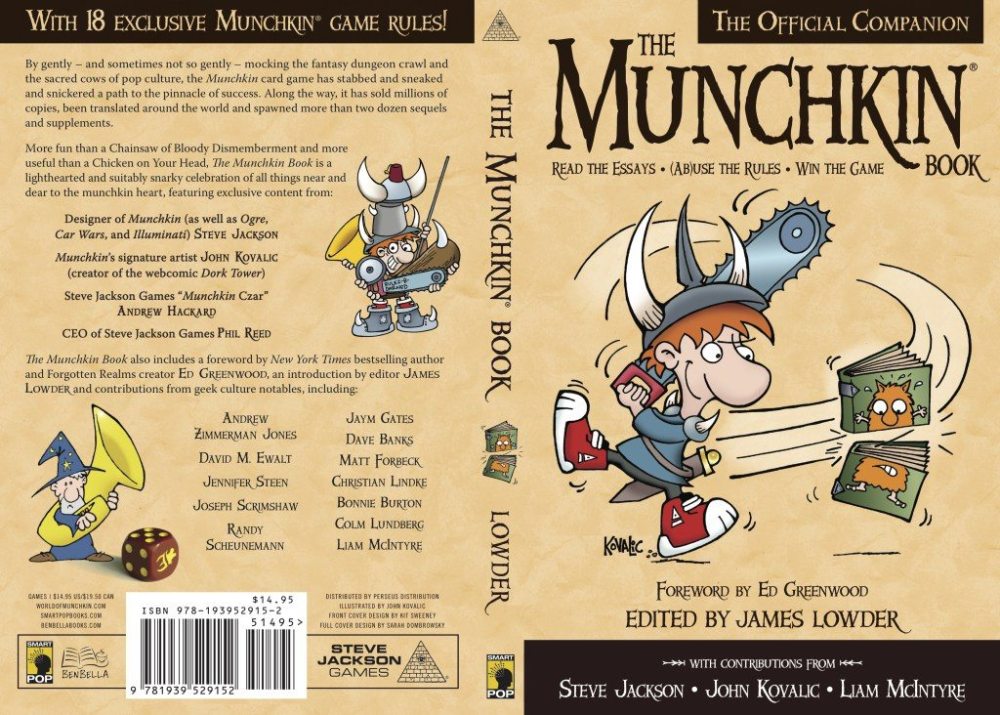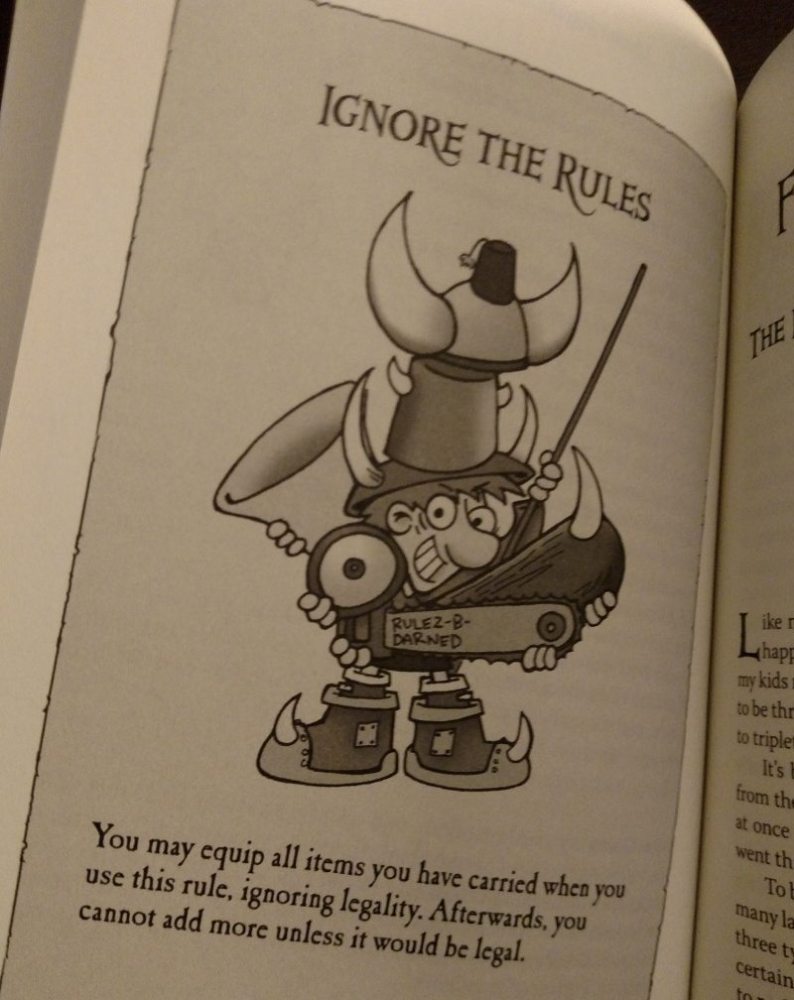There’s an awful lot I like about Munchkin, even though I only get to play it rarely these days. The Munchkin Book – The Official Companion, recently published by Smart Pop, got me very much in the playing mood.
Several years in the making, The Munchkin Book is a collection of essays on Steve Jackson Games’ nearly 15-year-old game that’s gone through 29 printings–of just the base edition!–and has been translated into 17 languages.
I’ve written before about how much I enjoy the stories people share about the things that matter to them, so reading The Munchkin Book was an easy choice for me. And from the foreword by Ed Greenwood to the closing essay from Munchkin artist John Kovalic, I was entertained by the mix of authors and styles and thoughts on the game, with topics including game theory, RPG history, and parenting, as well as some straight-up humor pieces.
Andrew Zimmerman Jones’ “To Backstab or Not to Backstab: Game Theory and the Munchkin Dilemma,” for instance, talks strategies, cooperation, and betrayal:
Part of the reason Munchkin is so much fun is that its play options and rewards are so diverse. They cannot be reduced to easily quantified payoffs and losses. Game theory helps us at least rule out the worst strategies. For those who haven’t learned this lesson any other way, it can teach that being a continual jerk is not a good strategy. It can teach us that ignoring, or even rewarding, bad behavior has negative consequences.
But it cannot offer guaranteed paths to success in every single situation. Even the best strategy … has its limitations. At times, reputation must be sacrificed for a truly great move.
GeekDad’s Dave Banks’ essay, “From Candy Land to Munchkin: The Evolution of a Young Gamer,” is likely to strike a familiar chord with many geek parents who’ve itched to get their kids to the table for a certain game, only to find that things don’t necessarily go as planned those first few times–but that those necessary delays and detours turn out to be well worth the trip in the end:
We’d mix and match the cards to create humongous door and treasure decks, and giggle at the unpredictable combinations that came about as a result of combining the many sequels and expansion packs. A Cleric with Decaying Flab, a Sunday Bonnet, and Stick to Human Boots? One of us probably played it at some point. Some of the most outrageous combinations have produced some of the finest results, and all the laughter coming from our Munchkin free-for-alls has actually made my daughters more interested in playing.
Some afternoons, my son will sit at the dining room table, sorting through the decks, trying to cobble together the most ridiculous or powerful character possible. It reminds me of our idle play with Heroscape, ignoring the rules and just getting lost in the components.
I also really liked Christian Lindke’s chapter, “How Playing Munchkin Made Me A Better Gamer.”
It’s hard to imagine a session of Munchkin that doesn’t result in a wild story you can tell the next time you’re trying to recruit new players. The interaction of the cards creates narrative absurdities that beg to be shared … Best of all, the glorious madness of those tales stands as a reminder to even the most serious Very Serious Gamer: be open to disruption and surprise.
There are several “inside baseball” contributions as well:
Steve Jackson himself shares a bunch of fun facts in “Munchkin by the Numbers,” noting things like:
- Number of different races, classes, loyalties, mojos, factions, and accents in all versions of the game: 88.
- Number of edible Munchkin items we have released: One.
(It was 2008’s Munchkin Resurrection Cookie. And Jackson goes on to note: “What happened to most of those cookies: 8.” Ba-dum–tsssh!)
Munchkin Czar Andrew Hackard writes about the Munchkin creation process in “Madness in 168 Easy Steps,” GeekDad’s Matt Forbeck interviewed Steve Jackson Games CEO Phil Reed for “Emperor of Fun,” and John Kovalic discusses his favorite pieces from the more than 5,000 he’s drawn for the game.
Jaym Gates’ “Munchkin as Monomyth” looks at the game in the context of the classic hero’s journey and shared storytelling, and Of Dice and Men author David M. Ewalt talks Munchkin and RPG history.
Jennifer Steen’s “Monster Grievances” takes the form of a series of complaint letters to the munchkins from Monster Union 3872, formed to decide all dungeon business and decide how best to tackle the problem of these adventurers who just keep showing up “to kick down our doors, loot our rooms, and engage in destructive behavior.”
Other chapters include “Flirting 101: Throwing the Dice in Munchkin and in Love,” by Bonnie Burton, “Screw You, Pretty Balloons: The Comedy of Munchkin,” by Joseph Scrimshaw, Colm Lundberg’s “The Charity Rule,” “On with the Show: Confessions of a Munchkin Demo Pro,” by Randy Scheunemann, and “Munchkin Hollywood” by Liam McIntyre.
And as with pretty much any Munchkin tie-in product out there, The Munchkin Book also includes 17 new rules that can be used in gameplay. For instance:
(Of course, there are limitations: The book has to be within the vicinity of the table where Munchkin is being played, only one of the rules can be used in a game, and you can only use one of the rules per day. And the rule must be chosen before the game starts.)
Like the game that inspired it, there’s something here for just about any Munchkin fan’s favorite aspect: clever humor, terrible puns, gaming strategy, ridiculous rules, love for RPGs, and the value of a good time with fellow gamers.
Disclosure: GeekDad received a copy of this book for review purposes.





